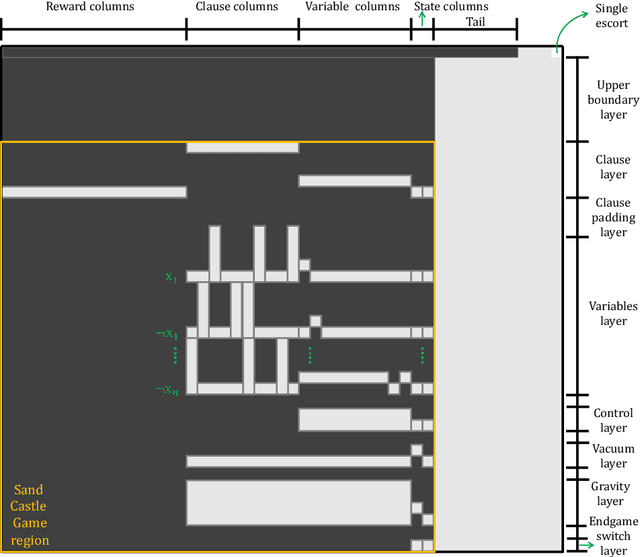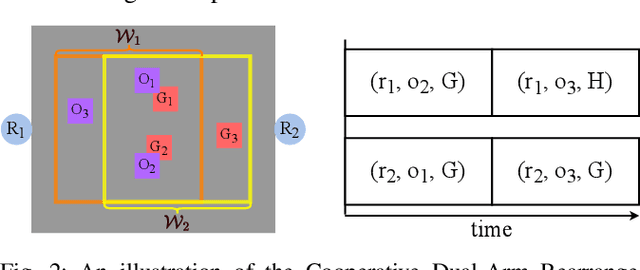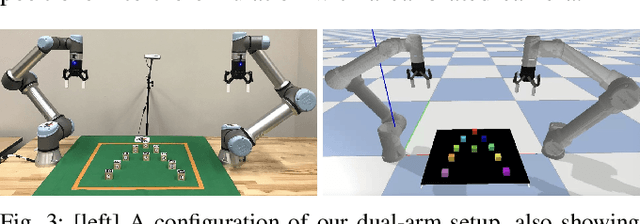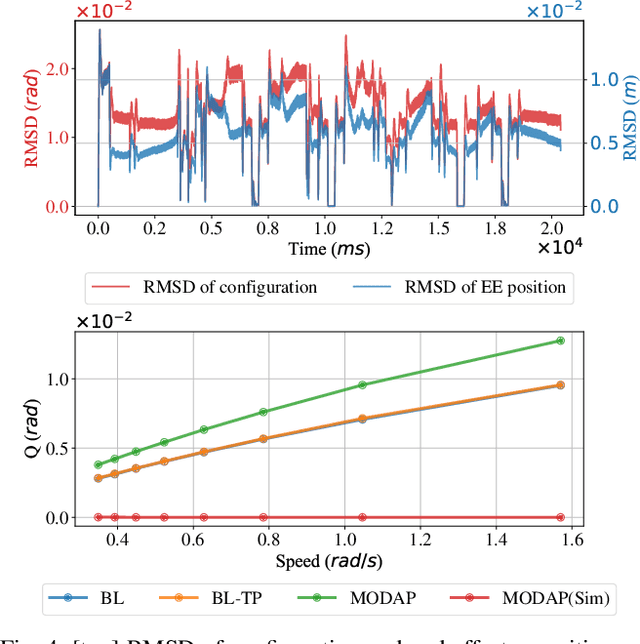Jingjin Yu
Fully Packed and Ready to Go: High-Density, Rearrangement-Free, Grid-Based Storage and Retrieval
May 28, 2025Abstract:Grid-based storage systems with uniformly shaped loads (e.g., containers, pallets, totes) are commonplace in logistics, industrial, and transportation domains. A key performance metric for such systems is the maximization of space utilization, which requires some loads to be placed behind or below others, preventing direct access to them. Consequently, dense storage settings bring up the challenge of determining how to place loads while minimizing costly rearrangement efforts necessary during retrieval. This paper considers the setting involving an inbound phase, during which loads arrive, followed by an outbound phase, during which loads depart. The setting is prevalent in distribution centers, automated parking garages, and container ports. In both phases, minimizing the number of rearrangement actions results in more optimal (e.g., fast, energy-efficient, etc.) operations. In contrast to previous work focusing on stack-based systems, this effort examines the case where loads can be freely moved along the grid, e.g., by a mobile robot, expanding the range of possible motions. We establish that for a range of scenarios, such as having limited prior knowledge of the loads' arrival sequences or grids with a narrow opening, a (best possible) rearrangement-free solution always exists, including when the loads fill the grid to its capacity. In particular, when the sequences are fully known, we establish an intriguing characterization showing that rearrangement can always be avoided if and only if the open side of the grid (used to access the storage) is at least 3 cells wide. We further discuss useful practical implications of our solutions.
PROBE: Proprioceptive Obstacle Detection and Estimation while Navigating in Clutter
May 17, 2025Abstract:In critical applications, including search-and-rescue in degraded environments, blockages can be prevalent and prevent the effective deployment of certain sensing modalities, particularly vision, due to occlusion and the constrained range of view of onboard camera sensors. To enable robots to tackle these challenges, we propose a new approach, Proprioceptive Obstacle Detection and Estimation while navigating in clutter PROBE, which instead relies only on the robot's proprioception to infer the presence or absence of occluded rectangular obstacles while predicting their dimensions and poses in SE(2). The proposed approach is a Transformer neural network that receives as input a history of applied torques and sensed whole-body movements of the robot and returns a parameterized representation of the obstacles in the environment. The effectiveness of PROBE is evaluated on simulated environments in Isaac Gym and with a real Unitree Go1 quadruped robot.
Optimally Solving Colored Generalized Sliding-Tile Puzzles: Complexity and Bounds
Oct 19, 2024



Abstract:The Generalized Sliding-Tile Puzzle (GSTP), allowing many square tiles on a board to move in parallel while enforcing natural geometric collision constraints on the movement of neighboring tiles, provide a high-fidelity mathematical model for many high-utility existing and future multi-robot applications, e.g., at mobile robot-based warehouses or autonomous garages. Motivated by practical relevance, this work examines a further generalization of GSTP called the Colored Generalized Sliding-Tile Puzzle (CGSP), where tiles can now assume varying degrees of distinguishability, a common occurrence in the aforementioned applications. Our study establishes the computational complexity of CGSP and its key sub-problems under a broad spectrum of possible conditions and characterizes solution makespan lower and upper bounds that differ by at most a logarithmic factor. These results are further extended to higher-dimensional versions of the puzzle game.
Asymptotically-Optimal Multi-Query Path Planning for Moving A Convex Polygon in 2D
Sep 05, 2024Abstract:The classical shortest-path roadmaps, also known as reduced visibility graphs, provide a multi-query method for quickly computing optimal paths in two-dimensional environments. Combined with Minkowski sum computations, shortest-path roadmaps can compute optimal paths for a translating robot in 2D. In this study, we explore the intuitive idea of stacking up a set of reduced visibility graphs at different orientations for a convex-shaped holonomic robot, to support the fast computation of near-optimal paths allowing simultaneous 2D translation and rotation. The resulting algorithm, rotation-stacked visibility graph (RVG), is shown to be resolution-complete and asymptotically optimal. RVG out-performs SOTA single-query sampling-based methods including BIT* and AIT* on both computation time and solution optimality fronts.
Expected $1.x$-Makespan-Optimal MAPF on Grids in Low-Poly Time
Aug 09, 2024Abstract:Multi-Agent Path Finding (MAPF) is NP-hard to solve optimally, even on graphs, suggesting no polynomial-time algorithms can compute exact optimal solutions for them. This raises a natural question: How optimal can polynomial-time algorithms reach? Whereas algorithms for computing constant-factor optimal solutions have been developed, the constant factor is generally very large, limiting their application potential. In this work, among other breakthroughs, we propose the first low-polynomial-time MAPF algorithms delivering $1$-$1.5$ (resp., $1$-$1.67$) asymptotic makespan optimality guarantees for 2D (resp., 3D) grids for random instances at a very high $1/3$ agent density, with high probability. Moreover, when regularly distributed obstacles are introduced, our methods experience no performance degradation. These methods generalize to support $100\%$ agent density. Regardless of the dimensionality and density, our high-quality methods are enabled by a unique hierarchical integration of two key building blocks. At the higher level, we apply the labeled Grid Rearrangement Algorithm (RTA), capable of performing efficient reconfiguration on grids through row/column shuffles. At the lower level, we devise novel methods that efficiently simulate row/column shuffles returned by RTA. Our implementations of RTA-based algorithms are highly effective in extensive numerical evaluations, demonstrating excellent scalability compared to other SOTA methods. For example, in 3D settings, \rta-based algorithms readily scale to grids with over $370,000$ vertices and over $120,000$ agents and consistently achieve conservative makespan optimality approaching $1.5$, as predicted by our theoretical analysis.
Toward Holistic Planning and Control Optimization for Dual-Arm Rearrangement
Apr 10, 2024



Abstract:Long-horizon task and motion planning (TAMP) is notoriously difficult to solve, let alone optimally, due to the tight coupling between the interleaved (discrete) task and (continuous) motion planning phases, where each phase on its own is frequently an NP-hard or even PSPACE-hard computational challenge. In this study, we tackle the even more challenging goal of jointly optimizing task and motion plans for a real dual-arm system in which the two arms operate in close vicinity to solve highly constrained tabletop multi-object rearrangement problems. Toward that, we construct a tightly integrated planning and control optimization pipeline, Makespan-Optimized Dual-Arm Planner (MODAP) that combines novel sampling techniques for task planning with state-of-the-art trajectory optimization techniques. Compared to previous state-of-the-art, MODAP produces task and motion plans that better coordinate a dual-arm system, delivering significantly improved execution time improvements while simultaneously ensuring that the resulting time-parameterized trajectory conforms to specified acceleration and jerk limits.
Well-Connected Set and Its Application to Multi-Robot Path Planning
Feb 19, 2024Abstract:Parking lots and autonomous warehouses for accommodating many vehicles/robots adopt designs in which the underlying graphs are \emph{well-connected} to simplify planning and reduce congestion. In this study, we formulate and delve into the \emph{largest well-connected set} (LWCS) problem and explore its applications in layout design for multi-robot path planning. Roughly speaking, a well-connected set over a connected graph is a set of vertices such that there is a path on the graph connecting any pair of vertices in the set without passing through any additional vertices of the set. Identifying an LWCS has many potential high-utility applications, e.g., for determining parking garage layout and capacity, as prioritized planning can be shown to be complete when start/goal configurations belong to an LWCS. In this work, we establish that computing an LWCS is NP-complete. We further develop optimal and near-optimal LWCS algorithms, with the near-optimal algorithm targeting large maps. A complete prioritized planning method is given for planning paths for multiple robots residing on an LWCS.
Targeted Parallelization of Conflict-Based Search for Multi-Robot Path Planning
Feb 19, 2024Abstract:Multi-Robot Path Planning (MRPP) on graphs, equivalently known as Multi-Agent Path Finding (MAPF), is a well-established NP-hard problem with critically important applications. As serial computation in (near)-optimally solving MRPP approaches the computation efficiency limit, parallelization offers a promising route to push the limit further, especially in handling hard or large MRPP instances. In this study, we initiated a \emph{targeted} parallelization effort to boost the performance of conflict-based search for MRPP. Specifically, when instances are relatively small but robots are densely packed with strong interactions, we apply a decentralized parallel algorithm that concurrently explores multiple branches that leads to markedly enhanced solution discovery. On the other hand, when instances are large with sparse robot-robot interactions, we prioritize node expansion and conflict resolution. Our innovative multi-threaded approach to parallelizing bounded-suboptimal conflict search-based algorithms demonstrates significant improvements over baseline serial methods in success rate or runtime. Our contribution further pushes the understanding of MRPP and charts a promising path for elevating solution quality and computational efficiency through parallel algorithmic strategies.
Decentralized Lifelong Path Planning for Multiple Ackerman Car-Like Robots
Feb 19, 2024Abstract:Path planning for multiple non-holonomic robots in continuous domains constitutes a difficult robotics challenge with many applications. Despite significant recent progress on the topic, computationally efficient and high-quality solutions are lacking, especially in lifelong settings where robots must continuously take on new tasks. In this work, we make it possible to extend key ideas enabling state-of-the-art (SOTA) methods for multi-robot planning in discrete domains to the motion planning of multiple Ackerman (car-like) robots in lifelong settings, yielding high-performance centralized and decentralized planners. Our planners compute trajectories that allow the robots to reach precise $SE(2)$ goal poses. The effectiveness of our methods is thoroughly evaluated and confirmed using both simulation and real-world experiments.
On Computing Makespan-Optimal Solutions for Generalized Sliding-Tile Puzzles
Dec 18, 2023Abstract:In the $15$-puzzle game, $15$ labeled square tiles are reconfigured on a $4\times 4$ board through an escort, wherein each (time) step, a single tile neighboring it may slide into it, leaving the space previously occupied by the tile as the new escort. We study a generalized sliding-tile puzzle (GSTP) in which (1) there are $1+$ escorts and (2) multiple tiles can move synchronously in a single time step. Compared with popular discrete multi-agent/robot motion models, GSTP provides a more accurate model for a broad array of high-utility applications, including warehouse automation and autonomous garage parking, but is less studied due to the more involved tile interactions. In this work, we analyze optimal GSTP solution structures, establishing that computing makespan-optimal solutions for GSTP is NP-complete and developing polynomial time algorithms yielding makespans approximating the minimum with expected/high probability constant factors, assuming randomized start and goal configurations.
 Add to Chrome
Add to Chrome Add to Firefox
Add to Firefox Add to Edge
Add to Edge